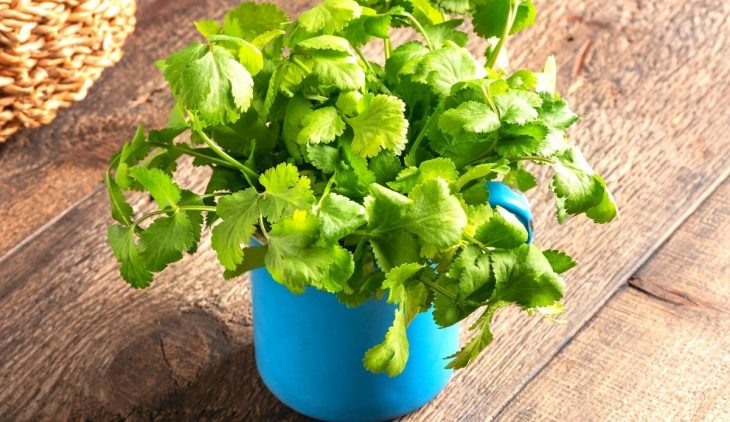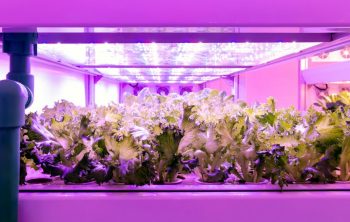It is essential to know how much sun does cilantro needs before planting, so you choose the right spot where it will thrive.
Cilantro is easy to grow and requires its own space in the garden where you can allow it to increase for as long as it needs.
It thrives in the cool weather of spring and fall, creating a result of lacy leaves. When the weather warms up, the plants end up being long skinny flower stalks. These bear flower clusters of pink or white blossoms later produce coriander seeds.
You can also plant cilantro in a bed devoted to herbs where it can be reseeded without disturbance. Cilantro makes a good winter companion to pansies in mild climates because these leaves can withstand a light frost.
Cilantro Vs. Coriander
Cilantro has been used for many centuries in India, Mexico, Africa, Russia, Spain, China, and many countries of Asia, especially Thailand and the Middle East. It is thought to be native to the Middle East and North Africa. In addition, cilantro has many culinary uses; cilantro seeds are used medically, especially as a sleep and digestion aid.
Almost in the whole of North America, the stalks and leaves of the Coriandrum Sativum plant are known as cilantro, while the dried seeds are known as coriander. However, different parts of the world refer to this plant as coriander and its seeds.

How Much Sunlight Does Cilantro Need?
Cilantro prefers well-drained, slightly acidic
Is cilantro sun or shade tolerant? Cilantro thrives under full sun. It also accepts light shade but not more than 2 hours of shade. When sowing your seeds, choose a spot that receives full sun for about 6 hours or more.
In scorching climates, light shade works better than direct sun. One way to judge the amount of shade allowed for the growing cilantro in your zone is by measuring the air temperature. The ideal growing temperature for cilantro crops is 64 degrees Fahrenheit.
Cilantro seeds should not be sown until the last date of spring frost.
Cilantro Growing Care Under The Sun
Cilantro, also known as coriander, can be grown from nursery transplants or seeds sown directly in the garden. Plant your seeds about 2 inches apart in rows based about 12 inches apart. If you are planting in pots, use a good amount of organic potting mix. Ensure that your
Cilantro always saves seeds, and you are likely to find a patch of cilantro producing new plants as long as you want. You can either leave the seeds to continue receding every season or harvest them and save them for planting in another season. That said, here are some essential tips on how to care for cilantro.
Cilantro Seed, Sprouting Seeds, Microgreen, Sprouting, 16 OZ, Non GMO
Provide Enough Light
Does cilantro need full sun? Cilantro loves bright indirect light, but it does not thrive under intense direct sunlight. That said, ensure that you provide your plants with a good amount of sun and shade if you live in a scorching area. However, if your location receives a minimum amount of sunlight, ensure that your cilantro receives about 6 hours of direct sunlight.
If you are growing your cilantro in container gardens, allow them to enjoy the morning sun in an east-facing window or a through a bright seal that does not get too much direct sunlight. If you plan to sow directly into the garden, plant them at a spot that receives the morning sun with afternoon shade.
Provide Rich, Well-drained Soil
Cilantro prefers a very light and fast-draining
Keep A Constant Watering Routine
Keep the
Provide The Right Growing Temperature And Humidity
Cilantro bolts in warm weather. Once bolting happens, it changes its flavor from being sweet to bitter. Flowering will occur quickly once the temperatures are above 75 degrees Fahrenheit. For potted plants, you can extend the harvest season by keeping the plants in a controlled environment. Keep them around 70 degrees F, bringing them indoors to an air-conditioned environment when outdoor temperatures get too warm.
Fertilize Your Plants
It would help not to fertilize cilantro, but you can use organic compost manure when planting. Use liquid fertilizer or supplement the
Pruning
Most gardeners do not know that cilantro requires pruning. To extend your cilantro harvest, snip of its soft stems regularly rotating the plant to encompass the whole plant. As the young plants grow, pinch back at least an inch to encourage fuller plants.
Potting And Re-potting
Cilantro is an annual plant that grows with a deep taproot. This means it does not like re-potting and will likely be damaged at the slightest provocation. Therefore, it is best to re-pot your garden center-bought cilantro only once after bringing it home. After that, keep your plant in that container for the rest of its life. Seed-grown cilantro can transition from your seed starting pot to its permanent home in another container or the garden. Because cilantro is an annual plant, mature plants should never be re-potted. A fully mature cilantro plant can grow up to a height of 24 inches, including its flower stalks.

Harvesting Cilantro
Cilantro leaves will be ready for harvest in about 3 to 4 weeks from the time you sow the seeds. Cilantro or coriander seeds can be harvested in about 45 days or when the plant is about 324 inches tall.
When harvesting, cut the leaves at the bottom of the plant to avoid harvesting more than 1/3 of the plant at the time. Cutting off too much can weaken the plant.
If you want to harvest, the seeds clip the seed heads and put them upside down in a paper bag. Give them a couple of days and the husks will dry, split and drop out the seeds inside the paper bag.
Cilantro Varieties You Can Grow Under The Sun
There are a few varieties that you can choose from they include
Santa – this variety has bushy leaves, and it is slow to become bitter
Calypso – this cultivar produces full plants that are among the slowest to get bitter or bolt.
Cruiser – best cultivar has full stems and large leaves and grows upright
Confetti – it is a highly ornamental variety with fern-like leaves
Leisure – it is a very standard type of cilantro that attracts beneficial insects like bees and butterflies.

FAQs
Where does cilantro grow best?
Cilantro is a hardy annual herb. In areas with mild winters it will come back year after year. In most areas it will not survive the winter unless you mulch or protect it from frost. It does not need much water and can be planted as early as late fall. It prefers to be in full sun, but will tolerate light shade. It does not tolerate wet soils and will not tolerate salty soil.
It can be planted in spring or fall.
What is the trick to growing cilantro?
You can either buy a ready-to-plant cilantro mix or start seeds indoors. Planting seeds is the easiest method. You can grow them in a pot in your kitchen window or under a grow light. Be sure to use a pot that drains well. When the seedlings are big enough to handle, plant them out in a sunny area and let them grow for a few weeks. Remove any weeds and then cut back to about 3 inches above the ground. Water frequently until they start to get bushy. After they have established themselves, you can plant them out in a sunny spot.
Does cilantro like a lot of light?
Yes, it does. If you are growing it in full sun, you will need to water it often. Cilantro likes light shade but doesn’t do well in deep shade. It is one of the few herbs that like a lot of heat. Cilantro does best in well-drained soil. A soil with some organic matter and compost is ideal. Do not let it dry out. In fact, water it more than your other herbs.
How do you care for an outdoor cilantro plant?
It's very easy to grow and will thrive in partial shade or full sun. It grows quickly and will produce seedheads in the fall. You can cut the plants back to ground level and they will regrow. Cilantro is used fresh in Mexican cooking and is also used as a garnish for Mexican dishes, especially seafood. It's an herb that should be planted in a container with good drainage and kept in a well-drained spot that receives full sun. The easiest way to fertilize is to add fish emulsion to your drip irrigation system. A good fertilizer for cilantro is fish emulsion (available at most nurseries). Apply this fertilizer once a month in the summer.
You need to water it every day in the summer, and keep it shaded if you live in a hot climate. It will produce a lot of leaves all summer, so when it starts to go to seed, cut the stems off and dry them. You can use them fresh in salads or stir-fries or even freeze them to make pesto.
Conclusion
How much sun does cilantro need? Let’s say enough sun. Because regions receive a varying amount of sun, it is best to ensure that your cilantro is not receiving too much or too little Sun.
Before planting your cilantro, check your area’s weather patterns to know how much sun you will receive. With this information, you will be able to decide how much sun and shade to provide.

Brian is an avid gardener who loves spending time outdoors. He is passionate about using his green thumb to create beautiful, lush gardens for her friends and family. He finds joy in tending to her garden, trimming plants, and cultivating new species. He enjoys to share his knowledge and experience with others with a similar gardening enthusiasm. Brian is a true nature enthusiast and a has true passion for the outdoors.





